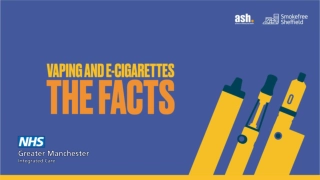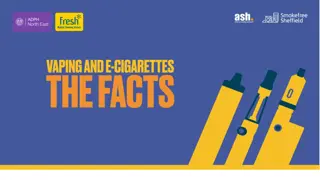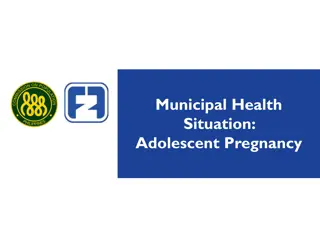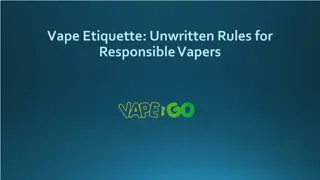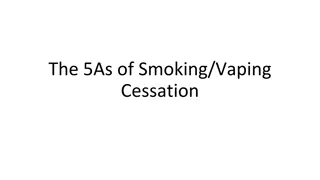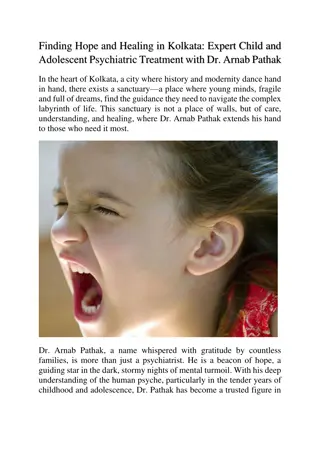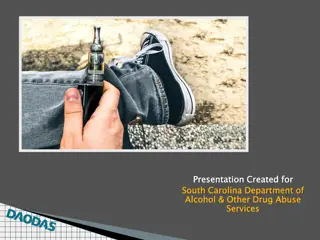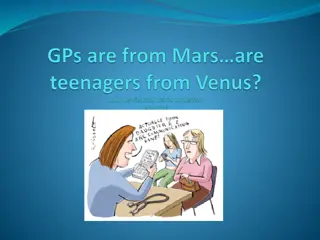Adolescent Vaping Trends and Issues
Adolescent vaping trends and issues are explored in this informative content, covering the evolution of e-cigarettes from first to third generation devices, as well as newer products like JUUL and IQOS/TEEPS/Heatsticks. Learn about the various types of e-cigarettes, their potential impact on adolescent health, and the latest developments in the vaping industry.
Download Presentation

Please find below an Image/Link to download the presentation.
The content on the website is provided AS IS for your information and personal use only. It may not be sold, licensed, or shared on other websites without obtaining consent from the author.If you encounter any issues during the download, it is possible that the publisher has removed the file from their server.
You are allowed to download the files provided on this website for personal or commercial use, subject to the condition that they are used lawfully. All files are the property of their respective owners.
The content on the website is provided AS IS for your information and personal use only. It may not be sold, licensed, or shared on other websites without obtaining consent from the author.
E N D
Presentation Transcript
TRENDS AND ISSUES IN ADOLESCENT VAPING Nicole Ward, MNSc, APRN, WHNP-BC C
What is an e-cigarette? Battery powered devices that use liquid cartridges to produce vapors for inhalation First version of the e-cigarette patented in 1965 Modern version created and patented by Ruyan company in China in 2003 There are currently over 400 brands and 7,000 flavorings available in the marketplace Bhatnagar et al., 2014
First Generation Sometimes called cigalikes Usually found at gas station counters Blu is a common brand Designed to look and feel like a cigarette, most are disposable Less effective at delivering nicotine May not be as satisfying to a smoker
Second Generation Mid size, pen style e-cigs Reusable, requires a chargeable battery and liquid refills Lager battery than 1stgeneration Some models allow user to adjust heat this alters the amount of vapor or changes the flavor of the juice
3rdGeneration Larger tank style systems Sometimes referred to as mods or APV s (advanced personal vaporizers) Have a much more powerful battery The level of Ohms produced by the battery is adjustable These are the most likely to have a battery explosion More effective at nicotine delivery
JUUL Considered an e-cigarette BUT.. Contains a much higher nicotine content Very potent Very effective at nicotine delivery with less vapor so there is less non-nicotine content inhaled and almost no cloud
IQOS/TEEPS/Heatsticks New to the market just approved for marketing by the FDA Widespread use in foreign countries Different than an e-cigarette Contains heat not burn tobacco Significantly lower levels of acrolein and formaldehyde Manufactured by Phillip Morris and will be marketed as a safer alternative to smoking
HARM VS. HARM REDUCTION C
Smoking is the Leading Cause of Preventable Deaths in the U.S. 440,000 Deaths/Year 876 crashes per year VS. 44 crashes per year Costs about $300 BILLION per year in healthcare dollars
Nicotine Addiction Biological Behavioral Social Psychological
Nicotine Delivery Continuum Of Risk Nicotine Replacement Combustible Cigarettes
Ingredients Some e-cigarette liquid contains diacetyl used in flavorings. This chemical causes bronchiolitis obliterans popcorn lung , a chronic irreversible lung disease. E-cigarettes Contain: Propylene Glycol or Glycerin Base Nicotine (some are nicotine free) Flavorings Heavy Metals Numerous other toxic substances Heat degradation of liquid of some products produces acrolein, formaldehyde, and carbonyls all carcinogens
Cardiovascular Issues Increased heart rate and blood pressure from nicotine exposure Limited evidence of short-term changes in endothelial dysfunction and arterial stiffness Insufficient evidence of long term changes in heart rate, blood pressure, or cardiac size or function No available evidence of altered cardiovascular outcomes resulting from long term use Interpretation No one has used an e-cig long enough to develop CVD or CAD but as the story unfolds it is definitely possible
Pulmonary Diseases No available evidence showing causation of respiratory diseases in humans but again, they haven t been used for a long period of time Limited evidence of respiratory harm in animal studies In adolescents increased coughing, wheezing, and asthma exacerbations Limited evidence of improved lung function and reduction of COPD exacerbations in adult smokers who quit or reduce smoking while using the e-cigarette Interpretation Kids should not use these as they may develop problems, adult smokers who have already destroyed their lungs may see improvement in symptoms (but not because of the e-cig, it s because they reduce their smoking)
Cancer Limited evidence from animal studies that cancer could develop over time, but no human evidence Limited evidence that vapor can cause DNA damage resulting in cancer development Substantial evidence that e-cigarettes contain chemicals that cause cancer but it is unknown if e-cigarettes create enough exposure to cause cancer Interpretation We don t really know but it s possible over time
Trauma Between 2012 and 2015, 92 traumatic events were reported (probably under reported) Batteries can malfunction and explode unexpectedly Causes facial trauma and thermal injuries Not to mention the injuries caused if it explodes in your pocket ..just saying
Poisoning Nicotine in E-liquid is highly concentrated Nicotine is poisonous to children and pets It can be absorbed through the skin Many liquids are marketed in flavors and packaging easily mistaken for candy Regulations are now in place for safety packaging but there is poor oversight EDUCATE YOUR E-CIGARETTE USERS ABOUT THIS DANGER CDC, 2014
Passive Exposure E-cigarettes do create airborne particulates and nicotine that can cause exposure to bystanders BUT It is at a lower amount than what is created by smoking E-cigarettes are not automatically included in clean indoor air laws Businesses and Public Areas must create policies to prevent e- cigarette use on their premises
Current Tobacco Product Use Among U.S. High School Students NYTS 2018 25 20 15 10 5 0 E-cigarettes Cigarettes Cigars Smokeless Hookah Pipe 2 or more Boys Girls
Increase in Use from 2011-2018 25 20 15 10 5 0 Percent reporting smoking in past 30 days 2011 2017 2018 Middle School High School
Reported use on 20 of the past 30 days among High School Students 2018 2017 0 5 10 15 20 25 30 Those who are using, are doing so more frequently
Perceived Risks of E-cigarette Use Among Youth NYTS 2016 Chart Title 40 35 30 25 20 15 10 5 0 Middle School High School No Harm Little Harm Some Harm A lot of Harm
What Do Teens Say Is In Their E-cig? Other Don t Know Just Flavoring Marijuana Other Don't Know Nicotine Marijuana Just Flavoring
Reasons for Youth E-Cigarette Use NYTS 2016 Series 1 Friend or Family member uses them Other Flavors Less Harmful To quit other tobacco products Public Use Easier to buy Cost Less Media Influence 0 5 10 15 20 25 30 35 40 45
Smoke and Mirrors Smoke and Mirrors A Juul Documentary https://www.youtube.com/watch?v=KTKu0A2ym0M
Key Phrases Buzz/Head rush Now don t feel it unless I need it Product looks really slick Juul is different than vaping vaping is lame It s the cool thing Don t have to go outside, smoking isn t as much fun Pod per day = 1 pack per day Don t know how to stop Not any medical research, so it must be safe
Why is this concerning? Biological Behavioral Social Psychological
What is the impact of Long Term High Dose Nicotine Exposure? While nicotine itself in controlled short- term doses may not be the most harmful part of smoking, it DOES have risks. Long term use may have implications for future Cardiovascular and GI health . Among other things. Very risk for kids with underlying undiagnosed conditions Marfan s, murmur s etc.
Is it a Gateway to Smoking? Depends on who you ask . The UK data says no Studies in the US show anywhere from 2-4X s the likelihood of experimenting with cigarettes. There are studies showing a higher correlation of early e-cigarette use and experimentation with other addictive substances.
Top Reasons Adolescents Shouldnt Vape It Develops a Lifetime Addiction to Nicotine which will require more and more nicotine The long-term effects of high dose nicotine use are potentially deadly
VAPING MARIJUANA C
Vaporizing Marijuana NYTS, 2016 Overall Middle School High School 0 5 10 15 20 25 30 35 40
Vaping Marijuana No Smell, no smoke, easy to conceal More than 50% of teens will try marijuana before they try cigarettes or alcohol Vaping results in higher concentrations of THC greater impairment Triggers dopamine release similar to nicotine, although not as addictive Affects structure and function of the brain, reduces brain volume, and has an impact on cognitive abilities Regular use Increased risk of mental health disorders Some vapes are pre-sold with CBD oil, JUUL does not but can be hacked
RECOGNIZING AND TREATING C
Recognizing Vaping at School and Home How Teachers can Recognize E-cigarette Use at School: https://www.youtube.com/watch?v=WLD7kW_uVEY Parents www.youtube.com/watch?v=Qsa7B7NfPBA
Issues for Parents Watch for signs such as: Drop in academic performance Moody Isolated Asking for money Sounds familiar if you have ever raised a teen! This leaves parents in a place where it is hard to detect vaping and nicotine addiction
Additional Signs to Watch For Increased Thirst vaping dries out the mouth Food is bland A dry mouth can reduce the ability to taste food flavors vapor s tongue Nosebleeds dry skin in the nose may lead to more frequent nose bleeds Acne bad breakouts in otherwise clear skin Reducing caffeine suddenly Pneumonia or recurrent upper respiratory infections Finding spare parts laying around unusual flash drives, battery chargers
Treatment A few years ago, it would ve been incredible to me that we would be here today discussing the potential for drug therapy to help addicted young people quit Dr. Scott Gottlieb No existing FDA approved treatment No guidance on dosing for NRT No idea if it really will even work Cold Turkey is not good if teen is frequent user Urgent national call for research on how to address nicotine addiction in adolescents methods may need to be different
FDA Comprehensive Plan The FDA views nicotine as highly addictive but delivered through products that represent a continuum of risk and is most harmful when delivered through smoke particles in combustible cigarettes FDA Commissioner Scott Gottleib, 2017 The FDA s Comprehensive Plan on Tobacco Focuses On: Reducing nicotine in cigarettes to below addictive levels Promoting innovative nicotine delivery methods Addressing youth smoking and nicotine use
Policy Changes How to keep the off ramp open while closing the on ramp. Vital that products are available for smokers who want to quit The message about harm reduction needs to change to harm reduction and not safe Increased enforcement online sales, sales in places where minors can access Tobacco 21
Take Aways E-cigarettes will reduce harm for people who are unable or unwilling to stop smoking with any other means E-cigarettes are not FDA approved for smoking cessation, but through shared decision making are being slowly accepted into healthcare guidelines Imperative that youth initiation on e-cigarettes is controlled at what cost is where the debate starts Adolescents are highly susceptible to nicotine addiction and suffer from withdrawal the same way adults do Treatment for nicotine addiction in adolescents is extremely limited Cessation strategies for vaping/juuling may need to be different than current strategies used for adult smokers Vaping Marijuana may be the next epidemic level problem with more and more states relaxing marijuana laws
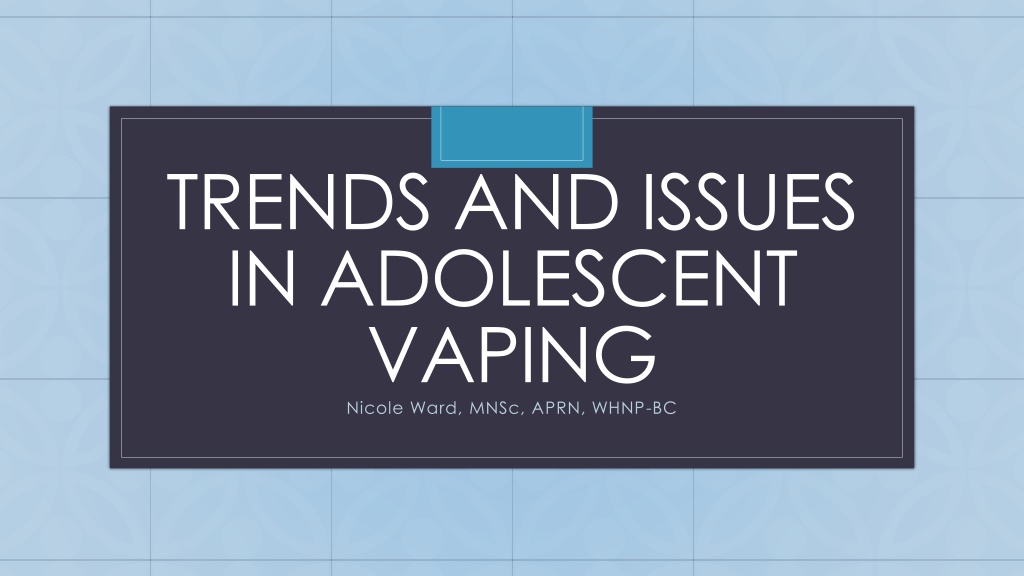
 undefined
undefined





